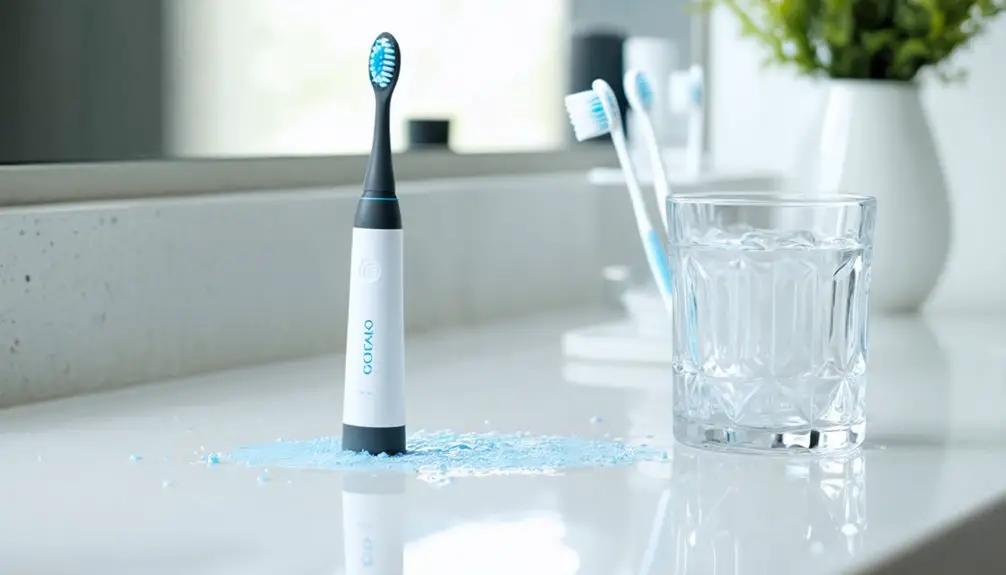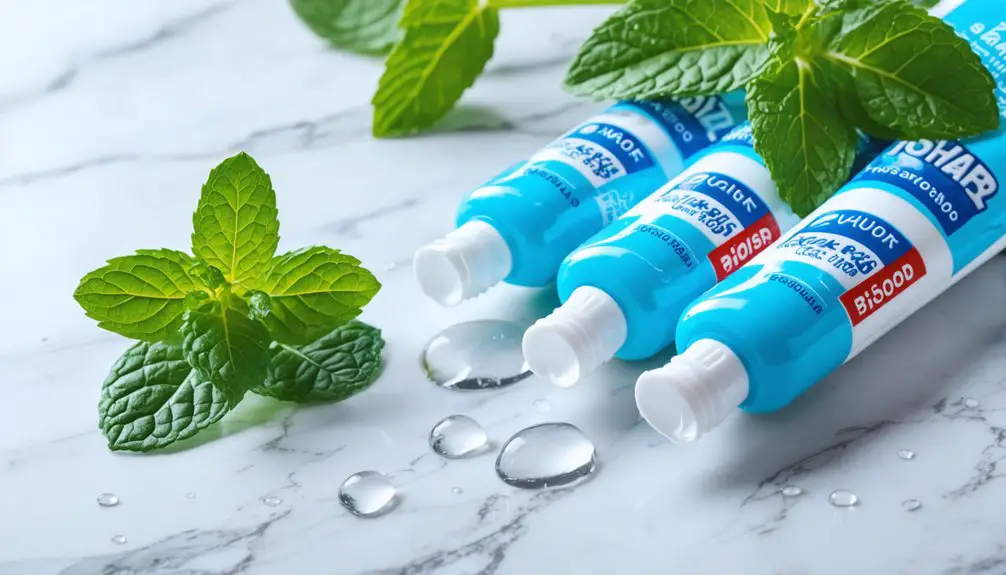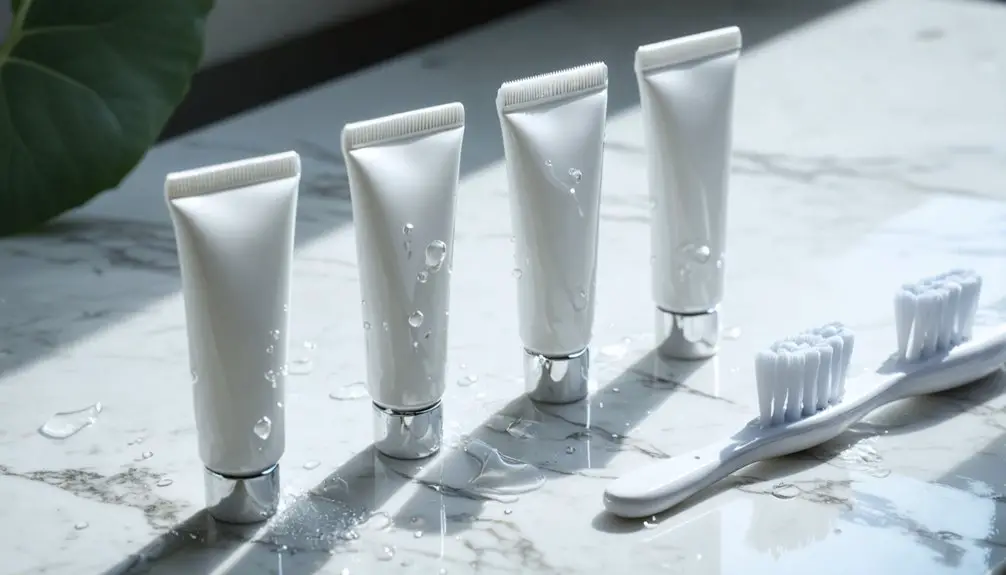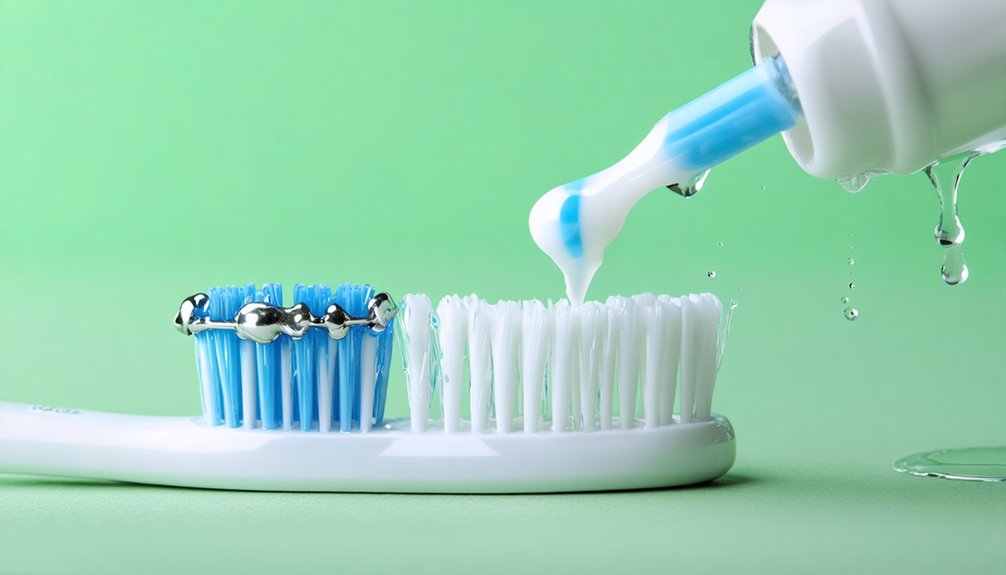For effective whitening results, choose a toothpaste containing hydrogen peroxide and gentle abrasives like baking soda. Brush with a soft-bristled toothbrush using moderate pressure for two minutes, twice daily, and wait 30 minutes after acidic foods before application. Use circular motions across all tooth surfaces, and incorporate fluoride products to protect enamel during whitening. While over-the-counter options work gradually, understanding proper technique and ingredient selection can greatly enhance your whitening success.
Key Takeaways
- Choose toothpaste containing hydrogen peroxide and fluoride for optimal whitening while protecting enamel strength.
- Brush gently with a soft-bristled toothbrush for two minutes twice daily using circular motions.
- Wait 30 minutes after acidic foods before brushing to prevent enamel damage during whitening.
- Use desensitizing toothpaste containing potassium nitrate before starting a whitening routine to minimize sensitivity.
- Maintain consistent daily use and avoid staining foods/drinks for best whitening results.
Understanding Key Whitening Ingredients
Five key ingredients dominate modern whitening toothpaste formulations: hydrogen peroxide, baking soda, activated charcoal, blue covarine, and natural compounds.
Among these whitening agents, hydrogen peroxide demonstrates the strongest clinical evidence, particularly at higher concentrations like 35%, though it can increase enamel sensitivity. The growing demand for aesthetics reflects the influence of social media on modern dental care.
Research confirms hydrogen peroxide’s superior whitening power at 35% concentration, despite potential tooth sensitivity concerns.
Baking soda offers effective mechanical stain removal while being gentler than other abrasives, making it an excellent choice for daily use. For more intensive whitening, professional in-office treatments provide immediate results using concentrated peroxide formulations.
You’ll find varying ingredient effectiveness across the spectrum. Activated charcoal removes surface stains but won’t alter your teeth’s natural color.
Blue covarine creates an optical illusion of whiteness by depositing a thin blue film.
Natural ingredients like lemon juice and strawberries show potential but require longer application times and may pose risks to enamel integrity if used improperly.
Choosing the Right Formula for Your Needs
Selecting a suitable whitening toothpaste requires careful evaluation of four critical components: remineralization agents, abrasiveness levels, whitening compounds, and sensitivity considerations.
When comparing ingredients, you’ll want to verify your toothpaste contains either fluoride or hydroxyapatite for enamel protection. For optimal whitening results, select a toothpaste containing hydrogen peroxide as a key active ingredient.
Check the RDA value to confirm moderate abrasiveness that won’t damage your teeth. Dental provider consultation is recommended to determine the most appropriate whitening formula for your specific situation.
For formula effectiveness, consider whether you need peroxide-based whitening for deeper stains or if mechanical stain removal through gentle abrasives will suffice.
If you have sensitive teeth, look for formulations with stannous fluoride or potassium nitrate, while avoiding sodium lauryl sulfate.
Match your specific oral health needs with the right combination of active ingredients to achieve the best whitening results without compromising dental health.
Best Practices for Application and Timing
To maximize the effectiveness of whitening toothpaste, proper application techniques and timing must be meticulously followed. Use a soft-bristled toothbrush and apply gentle pressure during the recommended application duration of two minutes, twice daily. This daily frequency guarantees ideal stain removal while protecting your enamel. Brightening natural color occurs progressively with consistent use.
Time your brushing strategically throughout the day. While morning and evening brushing is standard practice, you’ll want to wait 30 minutes after consuming acidic foods or beverages before applying whitening toothpaste. This precaution prevents potential enamel damage. Taking regular breaks from whitening toothpaste if you experience tooth sensitivity or irritation can help maintain optimal oral health.
When brushing, focus on all tooth surfaces using circular motions, and rinse thoroughly afterward. For enhanced results, incorporate complementary practices such as flossing to address interdental stains and using an appropriate mouthwash to complete your whitening routine.
Managing Sensitivity While Whitening
You’ll want to protect your teeth during the whitening process by using desensitizing toothpaste containing potassium nitrate or hydroxyapatite at least 1-2 weeks before treatment.
Maintaining a “white diet” of non-staining, room-temperature foods while avoiding acidic and sugary items will greatly reduce discomfort and sensitivity. Professional whitening treatments can achieve up to eight shades of color improvement with less sensitivity than over-the-counter options.
Regular use of fluoride products and gentle brushing techniques will help strengthen your enamel and minimize nerve irritation throughout the whitening process. Using lower peroxide levels in whitening products can significantly decrease tooth sensitivity while still achieving desired results.
Protect While You Whiten
When undertaking teeth whitening treatments, managing sensitivity becomes essential for both comfort and long-term dental health. To protect your teeth while whitening, focus on proper whitening frequency and enamel protection strategies. Start with lower peroxide concentrations (5-6%) and limit application times to around 5 minutes to minimize nerve irritation. Using specialized whitening products designed specifically for sensitive teeth can significantly reduce discomfort during treatment.
You’ll want to strengthen your enamel before and during treatment using fluoride-containing products and calcium-rich foods. Consider professional fluoride treatments prior to whitening, and maintain consistent use of remineralizing agents throughout the process. A consultation with your local dental professional helps ensure appropriate whitening methods for your specific needs.
During treatment, use desensitizing toothpaste containing potassium nitrate, and apply specialized gels before whitening sessions. If you’re experiencing sensitivity, take over-the-counter pain relievers proactively and brush gently with lukewarm water using soft bristles.
Gentle Products Reduce Discomfort
Since sensitive teeth require special care during whitening, selecting gentle products becomes essential for maintaining comfort while achieving desired results.
Today’s sensitive solutions incorporate specialized ingredients that protect your enamel while gradually removing stains. These formulations balance effectiveness with gentleness through careful ingredient selection.
For ideal results with gentle whitening, follow these key practices:
- Choose toothpastes containing potassium nitrate or stannous fluoride, which calm nerve sensitivity while whitening.
- Limit whitening to twice-daily brushing sessions to prevent enamel erosion and heightened sensitivity.
- Look for products with mild abrasives and remineralizing agents like sodium fluoride to strengthen tooth surfaces during the whitening process.
Common Mistakes to Avoid
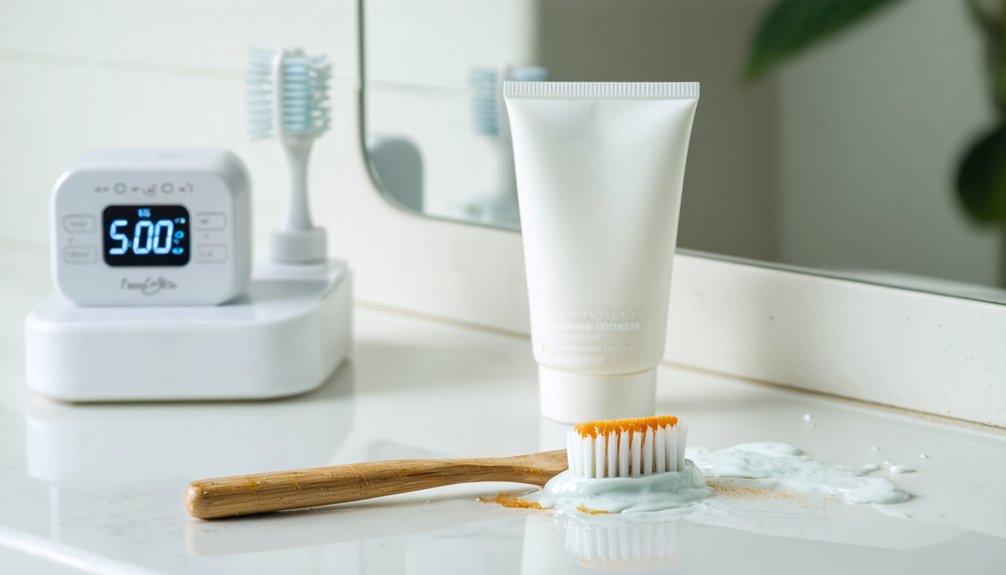
When using whitening toothpaste, you’ll need to avoid aggressive brushing techniques that can erode enamel and reduce whitening effectiveness.
Your toothbrush selection matters greatly – opt for soft bristles rather than medium or hard ones that can damage sensitive gum tissue during whitening treatments.
You’ll achieve best results by maintaining consistent daily use of your whitening toothpaste rather than sporadic application, which can lead to uneven coloration and diminished effects.
Brushing Too Hard
Although whitening toothpaste can effectively brighten your smile, brushing too hard can severely compromise your enamel’s integrity and counteract the desired results.
Excessive brushing pressure creates surface roughness that promotes bacterial adhesion and increases plaque accumulation, ultimately leading to potential gingival recession and tooth sensitivity.
To protect your enamel while whitening effectively:
- Use gentle, controlled strokes with a soft-bristled toothbrush to prevent unnecessary abrasion.
- Limit brushing duration to two minutes and frequency to twice daily to minimize cumulative damage.
- Apply minimal pressure, allowing the whitening agents to work without compromising enamel structure.
Remember that aggressive brushing with whitening products containing abrasives, particularly charcoal-based formulations, can accelerate enamel wear and create rough surfaces that are more susceptible to staining.
Wrong Toothbrush Selection
Selecting the wrong toothbrush can greatly diminish the effectiveness of your whitening toothpaste while potentially damaging your dental tissues. Hard bristles combined with whitening toothpaste’s abrasive properties can accelerate enamel erosion and increase tooth sensitivity.
Instead, opt for soft or medium toothbrush bristle types that provide thorough cleaning while protecting your enamel.
Your toothbrush size matters too. An oversized brush head may miss significant posterior areas, while small heads offer better access but require more brushing time.
Consider switching to an electric toothbrush, as it delivers consistent motion and pressure for superior stain removal. Remember to replace your toothbrush every three months or sooner if bristles become frayed.
When using whitening toothpaste with harsh abrasives, always pair it with softer bristles to maintain ideal dental health.
Inconsistent Usage Patterns
Many patients undermine their whitening results through inconsistent usage patterns of whitening toothpaste.
Product switching and irregular routines can greatly diminish the effectiveness of your whitening treatment while potentially causing dental sensitivity and enamel erosion.
To maintain ideal results and protect your oral health, follow these essential guidelines:
- Maintain consistent use of one ADA-approved whitening toothpaste rather than alternating between multiple products.
- Follow the manufacturer’s recommended frequency – don’t overuse or underuse the product, as both can compromise results.
- Schedule regular dental consultations to monitor your enamel health and adjust usage patterns based on your individual needs.
Remember that achieving lasting results requires a disciplined approach to your whitening routine while prioritizing your overall oral health.
Natural Vs Chemical Whitening Options
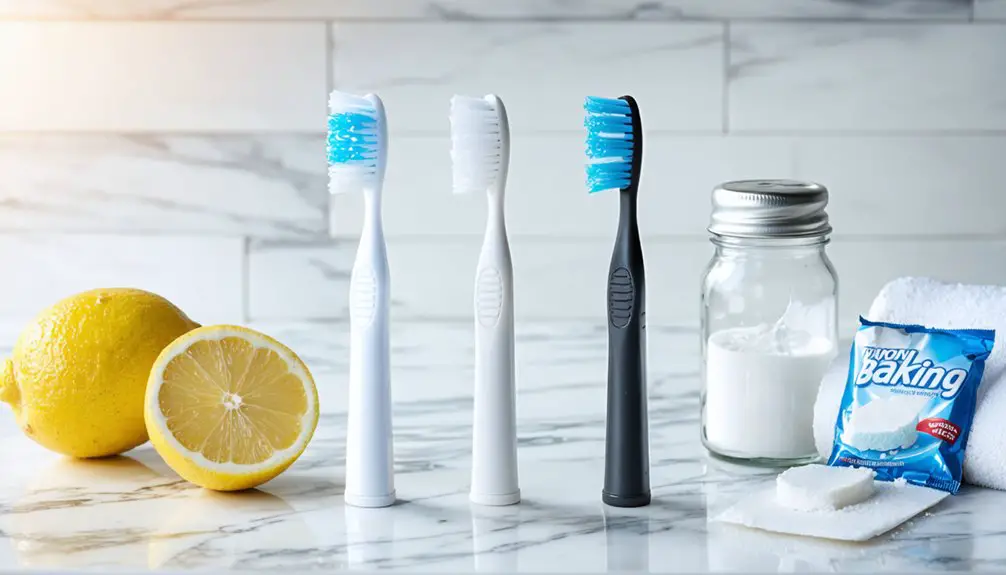
When choosing between natural and chemical whitening toothpastes, scientific evidence points to distinct differences in their efficacy and safety profiles.
Chemical options, containing hydrogen peroxide or carbamide peroxide, deliver faster and more dramatic whitening results, particularly for deep stains. They’re also typically more affordable and widely available. However, they can cause tooth sensitivity and enamel damage with prolonged use.
Chemical whitening toothpastes offer quick, powerful results but may damage enamel and increase sensitivity despite being cost-effective and accessible.
Natural options, while gentler on your teeth, work primarily through abrasives like baking soda and activated charcoal. They’re effective for mild surface stains and offer comparable plaque control to conventional toothpastes.
You’ll find they often exclude potentially irritating ingredients like sodium lauryl sulfate and artificial preservatives. While their whitening action may be slower, they present fewer risks of adverse effects on your dental health.
Maximizing Results Through Proper Technique
To maximize the effectiveness of whitening toothpaste, proper brushing technique plays an essential role in achieving ideal results while protecting your dental health.
By implementing effective techniques and best timing, you’ll enhance the whitening process while safeguarding your enamel.
Follow these essential steps for best results:
- Use gentle, circular motions with a soft-bristled brush for two minutes, focusing on visible front teeth.
- Apply a pea-sized amount and avoid immediate rinsing to allow peroxide activation.
- Maintain consistent twice-daily applications while avoiding excessive use that could cause sensitivity.
You’ll notice gradual improvement over several weeks of proper application.
For enhanced outcomes, complement your whitening routine with regular flossing and reduced consumption of staining beverages.
Frequently Asked Questions
Can Whitening Toothpaste Remove Coffee Stains From Dental Crowns or Veneers?
You’ll get limited results using whitening toothpaste on dental crowns, as it only removes surface coffee stains through gentle polishing but can’t change the restoration’s intrinsic color or deeper stains.
How Long Should I Wait After Eating Before Using Whitening Toothpaste?
Wait 30 minutes after eating to minimize tooth enamel sensitivity and guarantee ideal brushing timing. Your teeth need this recovery period to remineralize before using whitening toothpaste effectively.
Is It Safe to Use Whitening Toothpaste While Wearing Braces?
Like walking on thin ice, braces care requires caution. You can use whitening toothpaste, but it’ll cause uneven teeth whitening since brackets block areas. Choose non-abrasive formulas and consult your orthodontist first.
Should Whitening Toothpaste Be Stored at a Specific Temperature?
Store your whitening toothpaste between 59-77°F (15-25°C) in cool, dry conditions. Higher temperatures can degrade peroxide ingredients, while proper storage conditions help maintain the product’s whitening effectiveness.
Can Children Use Whitening Toothpaste, and at What Age?
For whitening safety and children’s dental health, you shouldn’t use whitening toothpaste until your child’s permanent teeth have fully erupted and matured, typically around age 14-15, with dentist approval first.
References
- https://pmc.ncbi.nlm.nih.gov/articles/PMC6369603/
- https://www.cnet.com/health/personal-care/best-whitening-toothpaste/
- https://advancedemeralddentistry.com/best-teeth-whitening-toothpaste-brands/
- https://www.goodhousekeeping.com/health-products/g44176844/best-whitening-toothpastes/
- https://www.supersmile.com/blogs/supersmile-blog/best-whitening-toothpaste
- https://pmc.ncbi.nlm.nih.gov/articles/PMC10024105/
- https://www.todaysrdh.com/what-the-research-shows-regarding-the-efficacy-of-dental-whitening-options/
- https://www.frontiersin.org/journals/dental-medicine/articles/10.3389/fdmed.2021.687507/full
- https://pmc.ncbi.nlm.nih.gov/articles/PMC4058574/
- https://ec.europa.eu/health/scientific_committees/opinions_layman/en/tooth-whiteners/index.htm
